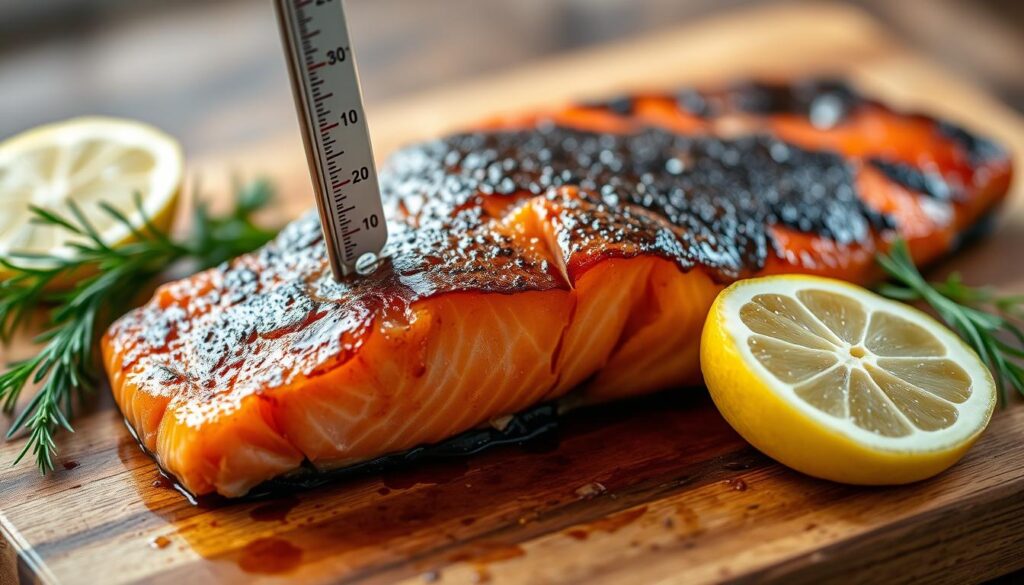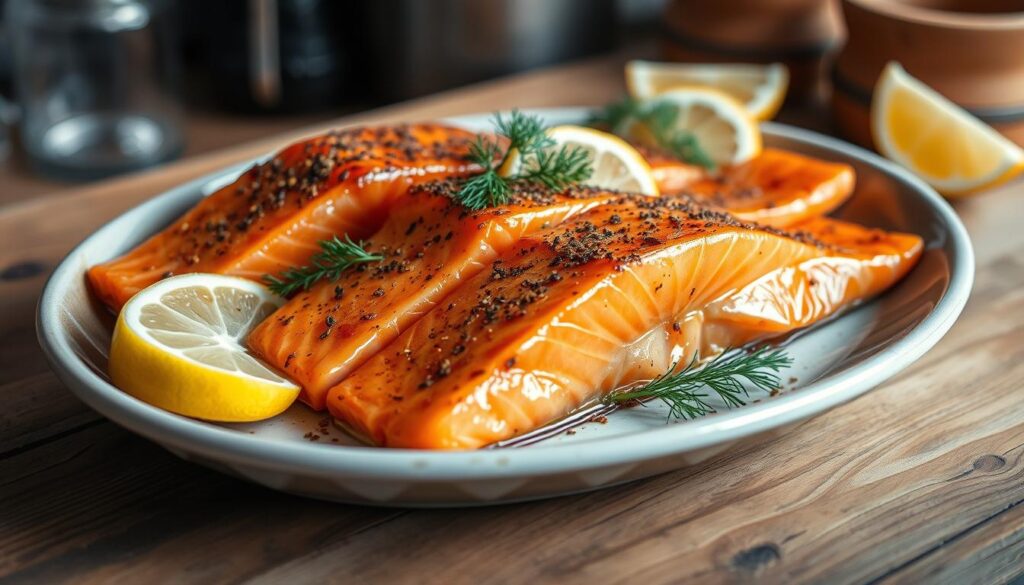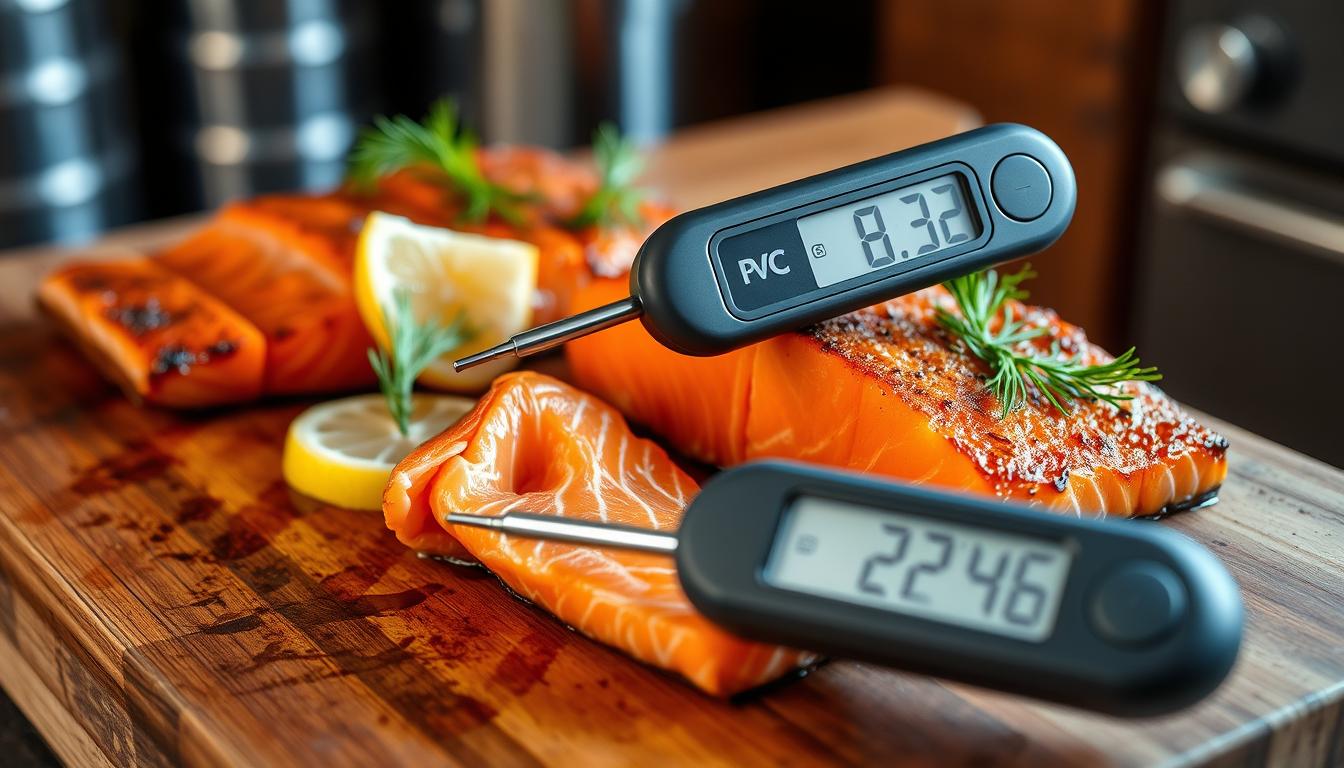There’s nothing quite like the smell of smoked salmon in the kitchen on a lazy Sunday. Its salty-sweet taste and soft texture make it a favorite for brunch. But getting the right internal temperature is key for both taste and safety. As someone who loves smoked fish, I’m excited to share how to smoke salmon perfectly at home.
Table of Contents
Understanding the Science of Smoked Salmon
Making perfect smoked salmon is a mix of art and science. It starts with the salt cure, a key step. This process removes moisture and harmful bacteria from the fish.
As the bad bacteria die, good lactobacillus bacteria grow. They eat the sugar, making the environment even more acidic.
Salt and Sugar at Work
Salt and sugar are crucial in preserving the salmon. Salt pulls out moisture, while sugar feeds the good bacteria. This teamwork keeps the cured salmon fresh and prevents spoilage.
The Function of Smoke
Smoking is a traditional way to keep fish fresh. The wood smoke has compounds that kill microbes and stop bad flavors. This step is key in making smoked salmon.
Pellicle Formation
During the salt cure, proteins move to the salmon’s surface. As it dries, a sticky, shiny layer called the salmon pellicle forms. This layer keeps moisture in and helps smoke penetrate.
A good pellicle is essential for the quality of the cured salmon skin.
“The pellicle helps the fish to retain its moisture and aids in smoke penetration during the cook. A fully-developed pellicle is very important to the quality of the final product. Without this tacky skin, the salmon would become very dry.”
The Difference Between Hot and Cold Smoking
Smoking fish can be done in two main ways: cold smoking and hot smoking. Knowing the differences between these methods is key to making perfect smoked salmon.
Cold Smoking
Cold smoking keeps the temperature between 68-86°F (20-30°C) for 6-12 hours. This method makes the fish denser without cooking it. The outside stays soft, unlike when cooked at higher temperatures.
But, cold-smoking has a big food safety risk. The meat stays in the danger zone for hours, which can lead to bacterial growth. It’s best left to experts who follow strict safety rules to prevent this.
Hot-Smoking
Hot-smoking uses a temperature of 150-170°F (66-77°C), well above the danger zone. The fish is smoked until it reaches the desired internal temperature. This high temperature kills any bacteria, making the salmon safe to eat.
To keep the smoker at the right temperature, using a precise thermometer is crucial. Tools like ThermaQ® help maintain the perfect temperature.
| Cold Smoking | Hot Smoking |
|---|---|
| Temperature range: 68-86°F (20-30°C) | Temperature range: 150-170°F (66-77°C) |
| Duration: 6-12 hours | Duration: Until desired internal temp is reached |
| Texture: Soft exterior, dense flesh | Texture: Flaky, cooked through |
| Food safety concerns: Increased risk of bacterial growth | Food safety: Kills existing microbes |
Choosing between cold smoking and hot smoking depends on your preferences and goals for smoked salmon. Understanding these techniques helps you make the best choice and get perfect results every time.
Fish Temperatures From Raw to Overcooked
Cooking fish right is all about knowing how temperature changes its texture and doneness. Harold McGee explores these changes in his book On Food and Cooking.
At 70°F, fish is soft and slick. As it warms to 100°F, it gets softer and wetter. At 110°F, the protein starts to shrink, making the flesh firmer and more opaque.
As the temperature goes up, so does the fish’s texture. At 120°F, it becomes firmer and juicier. At 130°F, it starts to flake. By 140°F, it’s firm and dry. At 150°F, it’s stiff and dry, with all protein fully denatured.
| Temperature | Fish Texture |
|---|---|
| 70°F | Soft, slick, smooth, and translucent |
| 100°F | Softer and more wet |
| 110°F | Protein begins to shrink, flesh becomes firmer and more opaque |
| 120°F | Flesh firms up, becomes more fibrous and juicy |
| 130°F | Flesh starts to separate into flaky layers |
| 140°F | Flesh becomes firm, dry, and fragile |
| 150°F | Flesh is stiff and dry, with all protein fibers fully denatured and coagulated |
Knowing how fish cooking temperatures affect fish texture by temperature is key to perfect smoked salmon.
Recommended Smoking Thermometer
When smoking salmon, the right thermometer is key. The best thermometer for smoking salmon is the ThermaQ. It’s a dual-probe device that lets you watch both the smoker and meat temperatures at once.
The ThermaQ uses accurate thermocouple probes for precise readings. This helps you track your smoked salmon’s progress. Its high and low alarms help keep the temperature just right, so your salmon turns out perfect.
The ThermaQ’s dual probe functionality lets you check the smoker and salmon temperatures. This gives you the control needed for delicious smoked salmon. It’s all about achieving that perfect flavor and texture.
“The ThermaQ is an essential tool for any serious home smoker. Its dual-probe design and precise temperature monitoring make it the perfect companion for smoking salmon to perfection.”
Whether you’re a pro or new to smoking salmon, the ThermaQ is a must-have. Its easy-to-use design and reliable performance ensure your smoked salmon will always be a hit.
Smoker Temperature and Meat Pull Temperature
Smoking salmon requires the right temperature to get the best texture and flavor. Experts say the ideal smoking temperature for salmon is around 150°F (66°C). This low temperature keeps the salmon soft and juicy.
To get the salmon just right, pull it from the smoker at 120°F (49°C). This temperature, as Harold McGee suggests, makes the salmon tender but still juicy. Cooking it too long can make it dry and tough.
“The ideal internal temperature for smoked salmon is between 120-135°F (49-57°C), as this is the point where the fish’s tender protein firms up and turns opaque, but remains juicy and delicious.”
By keeping the ideal smoking temperature for salmon and pulling it at the optimal salmon internal temp, you’ll get a moist and tasty smoked salmon every time.
Getting the perfect smoked salmon is all about finding the right balance of temperature and cooking time. Follow these tips to make a delicious smoked salmon dish that will impress anyone.
Smoked Salmon Internal Temp
Getting the perfect smoked salmon is all about watching the internal temperature. The ideal smoked salmon internal temp is key to that soft, moist texture. This is what makes great smoked salmon stand out.
The USDA says the safe temp for smoked salmon is at least 145°F (63°C). But, to keep the fish tender and flavorful, most chefs pull it when it hits 120-135°F (49-57°C).
This temperature keeps the salmon juicy and soft. Going over 135°F can make it dry and tough. It loses that delicious, soft feel.
To get the ideal smoked salmon internal temp, use a good meat thermometer. Stick it into the thickest part of the fillet. Check the temperature every 15-20 minutes until it hits 120-135°F.

“Patience is key when smoking salmon. Taking the time to carefully track the internal temperature will ensure you end up with a piece of smoked salmon that’s cooked to perfection.”
Best Types of Salmon to Smoke
For smoking salmon, Atlantic and King (Chinook) salmon are top choices. They are bigger, fatter, and have a meaty texture. This makes them perfect for smoking. Wild-caught Sockeye salmon is smaller and drier, not ideal for smoking.
Coho salmon is a middle ground. It’s moderately fatty, which can work for smoking. But, it’s not as good as Atlantic and King salmon. Look for salmon that’s oily and fatty. This helps it stay moist and absorb smoky flavors.
| Salmon Variety | Suitability for Smoking | Fat Content | Texture |
|---|---|---|---|
| Atlantic Salmon | Excellent | High | Moist and Meaty |
| King (Chinook) Salmon | Excellent | High | Moist and Meaty |
| Coho Salmon | Good | Moderate | Moderately Moist |
| Sockeye Salmon | Fair | Low | Dry |
When picking salmon for smoking, focus on fat content and texture. High-fat fish like Atlantic and King salmon make the best smoked salmon. Leaner fish like Sockeye may not be as good.
How Long to Smoke Salmon
The time to smoke salmon changes based on the fillet’s size and thickness. A 2-2.5 lb salmon fillet usually takes 1-1.5 hours to smoke. This is at a temperature of 150-170°F (66-77°C).
Smaller 1-2 lb fillets smoke for 45 minutes to 1.5 hours. But, the best way to check if it’s done is by looking at the internal temperature. This is more accurate than just the cooking time.
Salmon is fully cooked at 145°F (63°C). But, for the best taste and texture, take it off the smoker at 120-135°F (49-57°C).
Several things can affect how long it takes to smoke salmon:
- Fillet size and thickness – Thicker fillets take longer.
- Smoker temperature – Higher temperatures cook it faster.
- Fat content – Fattier salmon might need less time.
- Starting temperature – Warmer salmon cooks faster than cold.
Regardless of the salmon’s size or thickness, using a meat thermometer is key. It ensures the fish is smoked to perfection, with a moist and delicious texture.

By following these tips and keeping an eye on the temperature, you’ll get delicious smoked salmon every time.
3 Tips for Perfect Smoked Salmon
Smoking salmon is an art that you can master at home. With a few key tips, you can make smoked salmon as good as a restaurant. These tricks are great for both seasoned smokers and beginners.
- Use a dual-probe digital meat thermometer to check both the smoker and salmon’s temperature. This ensures the salmon is cooked just right, at 145°F as the USDA suggests.
- Plan ahead – wet brine the salmon for 4-12 hours, then dry it in the fridge to form a pellicle. This helps keep moisture and flavor in. The brining process takes 16 hours in two steps: 8 hours covered and 8 hours uncovered.
- Start with the highest quality fresh or frozen salmon you can find. Make sure the fish doesn’t smell too fishy, as that means it’s spoiled. Good fish for smoking include white fish, trout, mackerel, bonito, wahoo, bluefish, and mullet.
By using these tips for smoking salmon and tricks for best smoked salmon, you’ll make delicious, restaurant-quality smoked salmon at home.
“Smoking salmon is an art, not just a cooking method. These tips will take your smoked salmon to the next level.” – Gourmet Magazine
Conclusion
Smoked salmon is a tasty dish perfect for many occasions. It can be enjoyed at a fancy brunch or as a quick snack. By learning the right temperatures and techniques, you can make it just like a restaurant at home.
Choosing the right salmon and keeping an eye on the temperature are key. These steps will make your smoked salmon tender and full of flavor. It’s sure to wow your guests.
Whether you’re experienced in cooking or just starting, the secret to great smoked salmon is in the details. With the right tools and attention to temperature and timing, you can turn fresh salmon into a delicious treat. So, don’t hesitate to try different methods to find what works best for you. The effort will be worth it for the amazing taste of your smoked salmon.
This article has given you the essential tips for perfect smoked salmon. Now, you have the knowledge to improve your cooking and impress your family and friends. Enjoy your culinary journey with smoked salmon!
FAQ
What is the safe minimum internal temperature for smoked salmon?
What is the optimal internal temperature range for tender, moist smoked salmon?
What are the key differences between cold smoking and hot smoking salmon?
What happens to the texture of salmon as the internal temperature increases?
What features should I look for in a thermometer for smoking salmon?
What is the ideal smoker temperature and internal pull temperature for smoked salmon?
What are the best types of salmon to use for smoking?
How long does it take to smoke a salmon fillet?
What are 3 key tips for perfect smoked salmon?
Source Links
- Smoked Salmon: Key Temperatures For Success – https://blog.thermoworks.com/key-temps-smoked-salmon/
- How to Smoke Salmon – https://www.theslowroasteditalian.com/how-to-smoke-salmon/
- How to Smoke Salmon – Make Succulent Smoked Salmon at Home – https://iowagirleats.com/how-to-smoke-salmon/
- Our Recommended Temperatures for Salmon and Other Seafood – https://blog.thermoworks.com/recommended-temperatures-seafood/
- How to Smoke Salmon at Home – https://www.seriouseats.com/how-to-smoke-salmon-recipe-8621746
- Microsoft PowerPoint – FINAL Principles of Fish Smoking April V2 – https://seafoodacademy.org/pdfs/Seafish-resources/Principles-Fish-Smoking-slides.pdf
- Differences Between Hot Smoking and Cold Smoking | ThermoPro – https://buythermopro.com/hot-smoking-vs-cold-smoking/?srsltid=AfmBOortwjzb6MYec29BWWbgVLlwM73DbIIeCRQVl2969fD2l2rnDhdc
- hot smoked salmon V cold smoked salmon V lox – https://provenderbrown.co.uk/what-is-the-difference-between-hot-smoked-and-cold-smoked-salmon?srsltid=AfmBOooQLDzwYMYWEly3n3qrecFs91BWDKebcqir1pGH9Ui7SXNFhP3s
- Cold Smoked Salmon – https://chefmichaelsalmon.com/cold-smoked-salmon/

